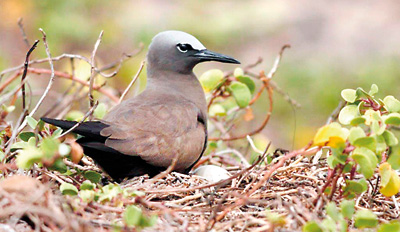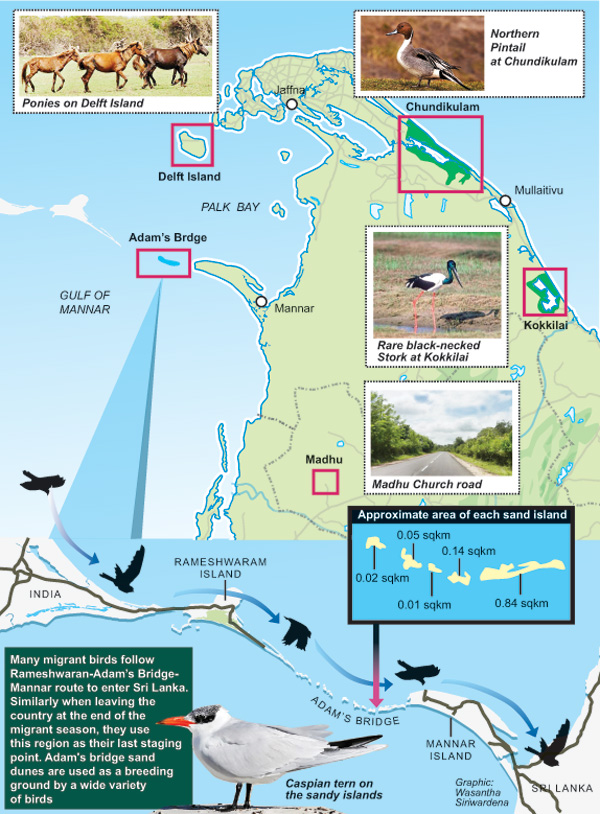News
Wild north gets Govt’s helping hand at last
The government has stretched out a hand of protection of the threatened wildlife across the north, from the ragged ponies of Delft to birds that breed only on a single islet in the Adam’s Bridge chain leading to India. Four new national parks will be set up across the north, the government announced this week. They will cover environmentally sensitive areas in Chundikulam, Madhu, Delft island and the Adam’s Bridge sand islands that belong to Sri Lanka.

Resident breeder not migratory: Nesting Brown Noddy on Adam's Bridge island. Pic by Vimukthi Weeratunga
Conservationists welcomed the move to protect the north’s unique eco-systems, overlooked for decades due to war and then came under pressure with post-war development plans. The decision was announced by Sports and Tourism Deputy Minister Wasantha Senanayake, who carries responsibility for the Department of Wildlife Conservation while President Maithripala Sirisena is Minister for the Environment.
Delft Island is the only place inhabited by wild ponies believed to have been brought to Sri Lanka by the Portuguese, who used Delft as a breeding centre. There are thought to be around 500 ponies today. The wilderness around the famous Madhu church and the Chundikulam bird sanctuary too will be gazetted national parks.The most unique area to be upgraded to national park status is Adam’s Bridge, a chain of limestone islands between Mannar and India’s Rameswaram island.
It is believed India and Sri Lanka were linked in ancient times and these are the remains of that land mass. There are eight islands on the Sri Lankan side and the furthest of them are very small and go under water at high tide. The third island from Mannar is special as it is used by thousands of seabirds for breeding, said biologist Vimukthi Weeratunga, who carried out a reconnaissance survey with fellow researchers Dr. Sampath Seneviratne and Professor Devaka Weerakoon of the University of Colombo.The team hopes to initiate a long-term study on the breeding ecology and relative abundance of birds of the sand islands. The island in question is less than five hectares but the research team found seven species of terns breeding there, building nests on the sand. Of these, six are listed as endangered species in Sri Lanka since this island is the only known breeding site in Sri Lanka for them, according to their research team.
The researchers also found a brown noddy nest with eggs on this island, which for the first time shows that this bird, thought to be migratory, is a resident breeder. Dr. Seneviratne, who has observed many seabird colonies in other parts of the world, says the density of birds in this island is high. He warned, however, that during the breeding season, fisherman reportedly often raid the island to collect the eggs. This is very disruptive, he said, commending the Navy for trying to give maximum protection to the island.
Prof. Weerakoon also cautioned that if more people start visiting these islands the breeding colonies would be disturbed and birds would abandon the island.
Declaring these Adam’s Bridge islands a national park should be done carefully as it would increase tourism, he said. The focus should be to conserve such remote locations without disturbances.
Conservationists stressed the importance of genuine and thorough protection for these areas and not simply labelling them “national parks”.
Remember that birds die because we use energy
On World Migratory Bird Day this weekend, Sri Lanka celebrates the 200 birds that migrate to the island annually and become an important part of this country’s biodiversity. These birds fly thousands of kilometres, even crossing great oceans, in order to reach their destinations during the two-way journey. They are vulnerable to dangers lying in their path that could bring devastating results even though the sites at their destinations are protected.
World Migratory Bird Day was declared to raise the awareness of these special creatures and the threats they face. “Energy – Make it Bird Friendly” is this year’s theme to highlight the harm faced every year by millions of migratory birds which struggle with the massive expansion of energy generation and distribution.
Collisions and electrocution due to power lines as well as barrier effects from energy infrastructure can cause death and displacement. Wind farms could be particularly disruptive if set up across migratory routes.
“We need clean and cheap power that doesn’t pollute environment, so we should find ways to minimise damage and keep monitoring the impact of energy infrastructure once it is set up,” said Devaka Weerakoon, Professor of Zoology at the University of Colombo.


